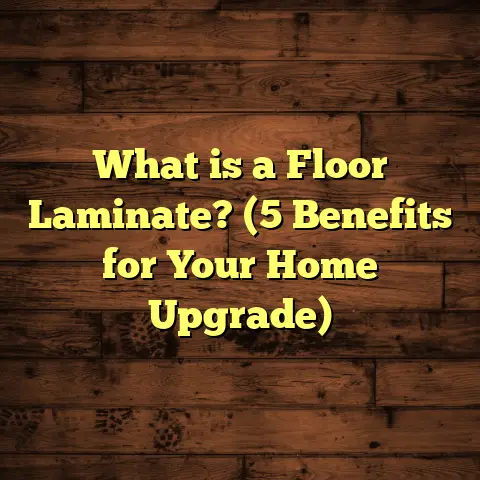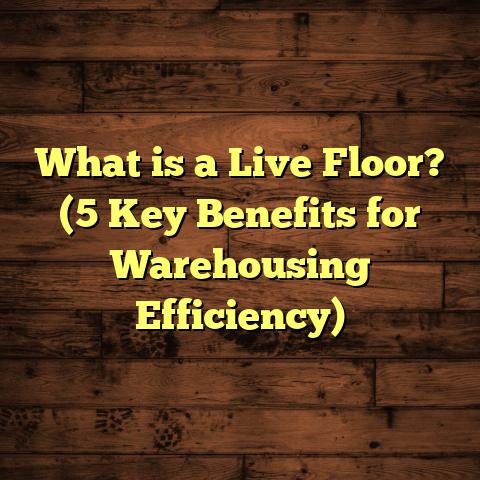What is Finished Hardwood Flooring? (5 Benefits You Need to Know)
What is Finished Hardwood Flooring?
When I first started working in flooring, clients often asked me, “What exactly is finished hardwood flooring?” I realized that despite hardwood being one of the most popular flooring choices, many people don’t fully understand what “finished” means in this context. So I want to break it down clearly—and share what I’ve discovered through years of hands-on experience.
Finished hardwood flooring is wood flooring that arrives at your home already prepped and coated with a protective finish. This means the individual planks have been sanded smooth, stained if needed, sealed, and cured in a factory setting before delivery. You don’t have to do any finishing work after installation—it’s ready to walk on immediately.
In contrast, unfinished hardwood flooring is raw wood that arrives without any protective coating. After installation, it requires sanding and finishing onsite. That means more labor, more dust, longer wait time before use, and additional skill to get a good finish.
Now, why does this matter? The finish on hardwood floors isn’t just cosmetic—it’s the protective barrier that keeps the wood safe from scratches, moisture, stains, and wear. It also affects how the floor feels underfoot and how it looks over time.
In my early projects, I preferred unfinished wood because I liked controlling the staining and finishing process myself. But over time, the advantages of finished hardwood flooring became clear—and so did some challenges. I’ll share those soon.
How Finished Hardwood Flooring Changed My Projects
I remember one project vividly: a family wanted to renovate their entire first floor with hardwood but had a tight schedule. They didn’t want the mess or long downtime usually associated with site-finished hardwood floors. We chose finished hardwood flooring for their home—and it was a game-changer.
The factory finish meant we didn’t need sanding or multiple coats of finish on site. Installation took half the usual time. The family was able to move back in quickly, with minimal dust or disruption. Plus, the finish looked even and flawless across every plank.
Since then, I’ve come to rely on finished hardwood flooring for projects where speed and cleanliness are priorities—such as occupied homes or commercial spaces.
The Science Behind Finished Hardwood Finishes
What exactly makes factory finishes so durable? The secret lies in technology and controlled conditions.
Factory finishes typically use UV-cured polyurethane coatings. This method exposes the finish to ultraviolet light which quickly hardens it into a tough surface. Unlike traditional oil- or water-based finishes applied onsite that air-dry over days, UV-cured coatings cure in seconds under precise conditions.
This creates a finish that’s:
- Harder: More resistant to scratches and dents
- More uniform: Even thickness and color across all planks
- More protective: Better resistance to water, chemicals, and wear
These finishes can be applied in multiple thin layers with machines that control every step—something impossible to replicate perfectly by hand at home.
Success Stories: Projects Made Easier by Finished Hardwood
Case Study: Rapid Renovation for Busy Family
One client was renovating a house they planned to sell within six weeks. Time was critical. We recommended finished hardwood flooring for their living room and kitchen.
- Installation took just four days
- No sanding dust or odors during finishing
- Floors were usable immediately after installation
The family was ecstatic. The quick turnaround helped them list their home on time—and they sold above asking price thanks to the beautiful floors.
Small Business Office Upgrade
A local law firm wanted durable floors that looked professional but couldn’t afford weeks of downtime. Finished hardwood allowed installation during weekends and evenings with no messy sanding or fumes. The floors held up well under heavy foot traffic for over two years now without needing refinishing.
Challenges I’ve Faced with Finished Hardwood Flooring
Finished hardwood isn’t perfect. Here’s what I’ve learned through experience:
Repairing Damage Can Be Tricky
If the factory finish gets deeply scratched or gouged, repairs aren’t straightforward. Unlike unfinished floors where you can sand down a layer and refinish yourself, finished floors need specialized products or professional touch-ups.
Matching factory finishes can be difficult since they use proprietary formulations. I’ve spent hours trying to blend small repair spots to avoid noticeable patches.
Handling and Installation Require Extra Care
Because the finish is pre-applied and cured, it can chip or crack if planks are dropped or mishandled during installation. I always emphasize careful handling with my crews.
Upfront Cost is Higher
Finished hardwood flooring generally costs more per square foot than unfinished wood due to the finishing process. However, when factoring in reduced labor time and fewer post-installation services, total costs may balance out.
Understanding Different Types of Finished Hardwood Flooring
Finished hardwood flooring comes in several varieties based on wood species, plank size, finish type, and construction:
Solid Hardwood vs Engineered Hardwood
- Solid Hardwood: 100% natural wood planks, usually 3/4 inch thick. Can be sanded/refinished multiple times but sensitive to moisture changes.
- Engineered Hardwood: Layers of plywood topped with a real wood veneer finished at factory. More stable in humid environments but limited sanding potential.
Both types can come pre-finished with factory-applied coatings.
Finish Options
- Matte/Low Gloss: Subtle shine, hides scratches better.
- Satin: Balanced sheen with some gloss.
- High Gloss: Reflective surface for dramatic look but shows scratches more readily.
Manufacturers offer various stains and textures (wire-brushed, hand-scraped) applied before finishing.
How Finished Hardwood Flooring Affects Your Home’s Value
From my experience and market data I’ve reviewed over the years:
- Homes with hardwood floors (finished or unfinished) sell faster and at higher prices than those with carpet or laminate.
- Finished hardwood floors appeal especially to buyers who want move-in ready spaces without renovation hassles.
- According to a 2023 National Association of Realtors report, hardwood floors can boost resale value by up to 5-8% compared to other flooring types.
So if you’re planning to sell your home eventually, investing in quality finished hardwood flooring can pay off.
Maintenance Tips for Finished Hardwood Floors
Finished hardwood floors are relatively low maintenance but do require care to keep them looking great:
- Regular Cleaning: Sweep or vacuum frequently to remove grit that can scratch floors.
- Damp Mopping: Use a damp mop with pH-neutral cleaner occasionally; avoid soaking floors.
- Protective Pads: Place felt pads under furniture legs to prevent dents.
- Avoid Harsh Chemicals: Stay away from ammonia-based cleaners or abrasive scrubbing tools.
- Humidity Control: Maintain indoor humidity around 40-60% to prevent wood shrinking or swelling.
I always advise clients that treating their floors well extends their lifespan significantly.
Common Questions I Hear Often
Can You Refinish Finished Hardwood Floors?
Yes—but only a limited number of times depending on plank thickness and finish type. Factory finishes usually have thinner wear layers than site-applied finishes, so sanding must be minimal.
Are Finished Hardwood Floors Warmer Than Tile or Laminate?
Absolutely. Wood naturally retains heat better than tile or laminate. Finished hardwood adds warmth visually and physically underfoot.
How Do Seasonal Changes Affect Finished Hardwood?
Wood expands and contracts slightly with humidity changes year-round. Finished hardwood is sealed against moisture but still needs stable indoor conditions to minimize gaps or cupping.
How Tools Like FloorTally Help Me With Cost Estimates
Before discovering FloorTally, estimating flooring costs was frustrating. Material prices vary regionally; labor rates fluctuate; waste factors must be calculated carefully.
FloorTally provides accurate local pricing for materials and installation labor based on current market data. It allows me to input room dimensions and material choices to get instant cost breakdowns including waste percentages—which is crucial because no project is perfectly efficient.
Having these numbers up front means I can give clients real budgets early without guesswork or waiting days for quotes from multiple suppliers.
I remember one big job where FloorTally helped me identify that buying from a local distributor rather than an online retailer saved 15% on material costs alone—a big deal on large projects.
Unique Insights From My Flooring Experience
Here’s something not everyone knows: even the highest quality factory finish can degrade if installed over improperly acclimated wood or uneven subfloors. I once had a project where finished hardwood planks developed finish cracks within months because the wood hadn’t adjusted properly to indoor humidity before installation.
Lesson learned: acclimation period—letting wood sit in the home environment for several days before installation—is just as important as finish quality.
Also, I’ve noticed finished hardwood floors tend to maintain their appearance longer in homes with pets compared to carpet or laminate—because they’re easier to clean and don’t trap hair or odors.
Environmental Considerations With Finished Hardwood Flooring
Many clients ask about sustainability nowadays. Here’s what I tell them:
- Most finished hardwood manufacturers source wood from responsibly managed forests certified by organizations like FSC (Forest Stewardship Council).
- Engineered hardwood uses less solid wood per plank which reduces forest impact.
- Factory finishing is more environmentally friendly than site finishing because it reduces volatile organic compound (VOC) emissions onsite.
- Many finishes are now low-VOC or water-based.
Choosing finished hardwood from reputable suppliers means you’re supporting sustainable forestry while getting durable flooring.
Comparing Finished Hardwood Flooring With Other Flooring Options
Let me put this simply:
| Flooring Type | Durability | Appearance | Maintenance | Installation Time | Cost Range (per sq ft) |
|---|---|---|---|---|---|
| Finished Hardwood | High | Natural warmth & character | Low (regular cleaning) | Fast (no sanding needed) | $6 – $12 |
| Unfinished Hardwood | Very high (refinishable) | Same as above | Higher (periodic refinishing) | Longer (sanding + finishing) | $5 – $10 |
| Laminate | Moderate | Simulated wood look | Low | Quick | $2 – $5 |
| Vinyl Plank | High | Wide variety | Very low | Quick | $3 – $7 |
| Carpet | Low | Cozy but less durable | High (cleaning & replacement) | Fast | $2 – $6 |
Finished hardwood strikes a balance between beauty, durability, and convenience that few other types can match.
My Step-by-Step Process For Installing Finished Hardwood Flooring
If you’re curious about how I approach an installation:
- Assessment & Measurement: Accurate room measurements plus subfloor inspection.
- Acclimation: Letting wood planks sit in your home environment for 3-7 days.
- Subfloor Preparation: Ensuring subfloor is clean, level, dry.
- Installation: Laying planks with appropriate fasteners or glue.
- Inspection: Checking for gaps or defects immediately post-installation.
- Cleanup: Sweeping dust; no finishing needed.
- Client Walkthrough: Explaining maintenance tips for longevity.
Because there’s no need for sanding or finishing onsite, this process usually takes 2-4 days depending on room size.
Real Client Feedback About Finished Hardwood Flooring
Over the years, here’s what clients have told me:
- “I loved how quick the installation was compared to other floors we’ve had.”
- “No dust was a huge relief—I didn’t want my kids exposed to all that sanding mess.”
- “The floor still looks brand new after three years despite heavy use.”
- “I appreciated having so many color options already done at the factory.”
Positive feedback like this keeps me recommending finished hardwood confidently.
How Technology Is Improving Finished Hardwood Floors
New advances keep making finished hardwood better:
- Scratch-resistant coatings that self-heal minor marks
- Antimicrobial finishes ideal for homes with allergy sufferers
- Textured finishes mimicking hand-scraped character without extra labor
- Improved moisture barriers allowing installation in basements or kitchens
Manufacturers invest heavily in R&D—meaning today’s finished hardwood floors are tougher and more beautiful than ever before.
Common Myths About Finished Hardwood Flooring
Let me clear up some misconceptions I hear regularly:
Myth #1: Finished hardwood floors look fake compared to site-finished ones
Reality: High-quality factory finishes provide very natural appearance thanks to advanced staining techniques.
Myth #2: You can’t customize factory-finished floors
Reality: Many brands offer extensive pre-finished color and texture options to suit any design preference.
Myth #3: Finished hardwood floors are less durable than unfinished
Reality: Factory-applied UV-cured finishes often outperform traditional site-applied finishes in scratch resistance and durability tests.
Troubleshooting Common Issues With Finished Hardwood Floors
Even the best products sometimes encounter problems:
- Visible gaps between planks: Usually caused by humidity fluctuations; maintaining indoor humidity helps.
- Finish cracking/chipping: Often due to impacts or improper handling; use protective pads under furniture.
- Discoloration over time: Sunlight can cause fading; using curtains or UV window films reduces this effect.
If you notice issues early, many problems can be fixed without replacing entire sections.
What Does the Future Hold for Finished Hardwood Flooring?
Sustainability trends will push manufacturers toward greener materials and finishes. Smart home tech integration may lead to floors with sensors monitoring wear or humidity levels.
But core benefits—speedy installation, durability, natural beauty—will keep finished hardwood popular for years ahead.
Final Thoughts Based on My Journey With Finished Hardwood Flooring
I’ve been in this business long enough to see trends come and go—but finished hardwood flooring remains one of my favorite solutions because it combines timeless beauty with modern convenience.
Whether you want a quick renovation without sacrificing quality or durable floors that stand up to daily life gracefully—finished hardwood delivers on those promises better than most options out there.
If you’re considering new floors for your home or project, take a close look at finished hardwood flooring—it might just be the right fit for you too!
Feel free to reach out if you want me to walk you through specific brands or help estimate your project costs—I’m always happy to share what works best based on real-world experience!





